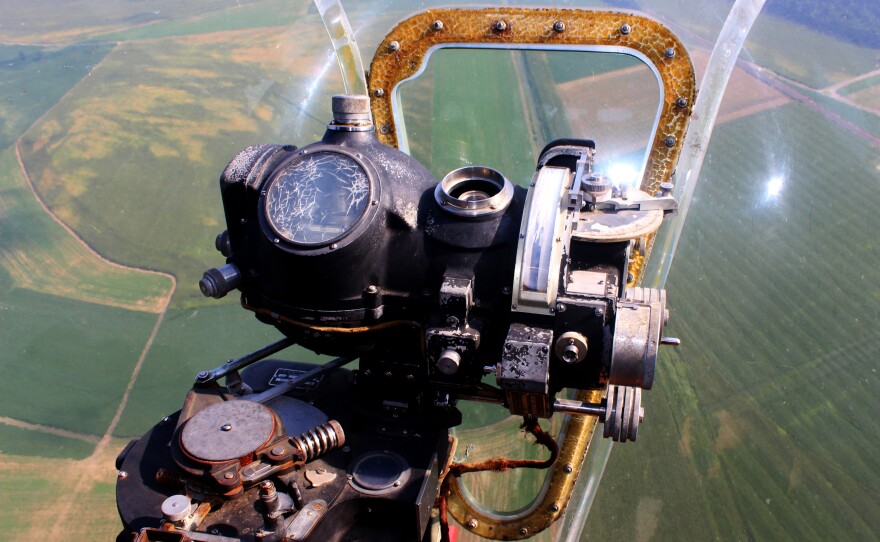During World War II, thousands of B-17 Flying Fortress bombers took to the skies daily. The planes were a crucial part of campaigns, from the bombing of Dresden to D-Day, and were flown by the likes of Clark Gable, Jimmy Stewart and Lt. Col. Basil Hackleman.
Hackleman, who now lives in Springfield, Mo., was the original pilot of the Nine-o-Nine, a celebrated B-17 that is said to have never lost a crew member or abort a mission because of mechanical failure. The plane was scrapped after the war.
“We got it in April of 1944. It was brand new — didn’t have a scratch on it," Hackleman said. "Of course, the Germans fixed that right away, but I flew 30 missions altogether, 14 in Nine-O-Nine.”
Hackleman was a Kansas farm boy when, in need of a job, he enlisted in the Army Air Corps in 1940. The United States entered World War II after the Japanese bombed Pearl Harbor on Dec. 7, 1941.
Hackleman said his most harrowing mission may have been a flight on Jan. 11, 1944.
“The fog was about 5 feet thick. You couldn’t see the ground from the cockpit,” he said. Pilots suffered heavy losses that day, but shot down one-fourth of the attacking fighter planes.
“When you are facing that many airplanes and everybody (is) shooting at you, you don’t think you have much of a chance to survive that kind of a day,” Hackleman said. “But we were just kids. We’re asked to do a job and that’s what you do.”

Hackleman had a few other close calls.
Later that year, a fighter pilot shot at the cockpit, sending one bullet over his shoulder, and one between his arm and his body.
“An inch either way would have killed me,” Hackleman said.
Another time, he lost two out of the B-17's four engines over Germany and had a third fail as he crossed the channel back to England. With only one engine left, Hackleman said he knew he did not have the power to clear the trees along England’s bank and had to coast into a beachside landing.
Hackleman was stationed at RAF Bassingbourn, an air force station in England, and traveled there with a 1935 silver certificate. Thirty-two crews, each with 10 men, left New Jersey and crossed the Atlantic Ocean in 1943, and all of the first pilots passed a $1 bill around for the group to sign.

“I’ve carried that (for) 70-something years now,” Hackleman said.
Of those 32 crews, only three completed all of their missions.
Today, only 10 B-17s are still flying. As part of the Collings Foundation’s Wings of Freedom tour, one of those B-17s stopped in St. Louis in August. An H-model B-17, this plane was converted to a G model. It was not deployed during World War II, but was used as a static test target for nuclear tests in Nevada. The plane was later sold for civilian use; in 1986, aircraft enthusiast Robert Collings, director of the Collings Foundation, bought it. The plane has been restored to WWII fighting condition and painted to resemble the Nine-O-Nine.
“We are a living history group," said Jim Harley, who has been flying with the Wings of Freedom Tour for five years. "Through flying these aircraft around the country we bring the museum to the people. We just want to keep history alive and make sure people don’t forget the greatest generation.”
In addition to the B-17, the tour travels with a B-24 Liberator and a P-51 Mustang fighter plane. Visitors can pay to fly in the planes, but it’s pricey. Harley said it costs more than $3,000 an hour to keep the Nine-O-Nine airborne.
“I’ve marveled at this country that could make all those air planes, make all that gasoline, and get it over there to us," Hackleman said. "We had the easy part: We used it. But someone had a heck of a job getting it over there to us — especially outrunning the German submarines. Nobody could do it by themselves, it took all of us.”
“St. Louis on the Air” discusses issues and concerns facing the St. Louis area. The show is produced by Mary Edwards and Alex Heuer and hosted by veteran journalist Don Marsh. Follow us on Twitter: @STLonAir.















